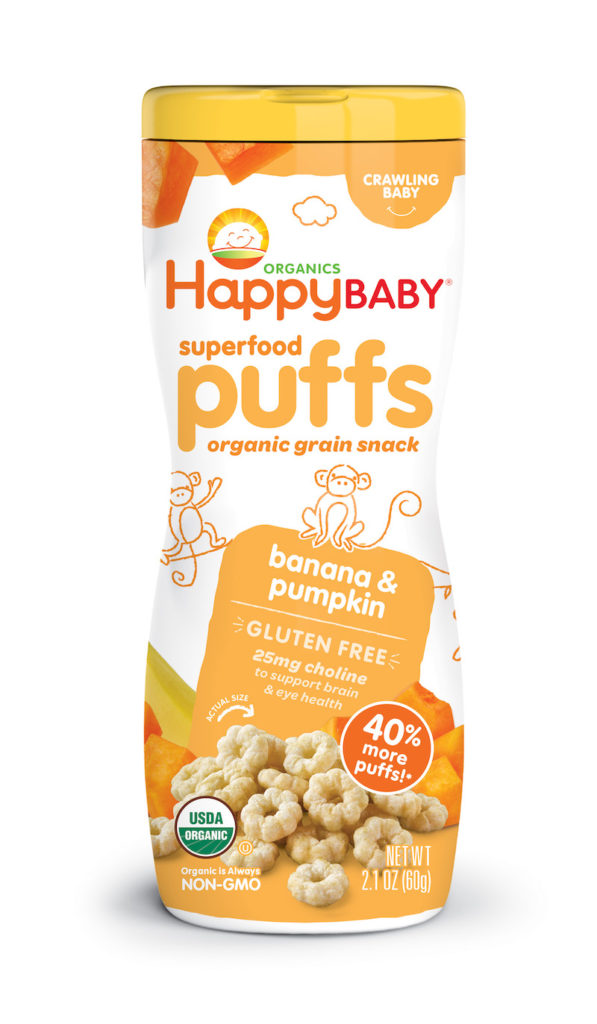Starting solid foods is an exciting time for you and your baby. Research shows that it is most beneficial to introduce solid foods around 6 months of age (but never before 4 months!).
During this time, you will continue to provide the essential nutrition and hydration needed from breast milk or formula, while also exposing your baby to a new world of diverse flavors and nutrients. In fact, this is one of the most influential periods in your baby’s taste development. Your baby will most readily try and accept all kinds of foods at this age so it’s important to offer a variety of different flavors from meal to meal.
The below meal, snack and recipe ideas will help you as you begin the fun journey into solid foods, while maximizing your baby’s taste development through varying tastes and flavors.

Remember, eating solids at this age is mostly about letting your baby explore new flavors and textures. Breast milk or formula will still remain your baby’s primary nutrition source for the first year, so continue to give breast milk and/or formula just as you were before starting solids.
Pro tips:
At around 6 months old, offering a few tablespoons of food a 1-3 times a day is sufficient. It’s important to advance texture once your baby is comfortable. Start with thin, pureed foods. Next, move to lumpy, mashed foods, followed by finely chopped foods. Also, introduce one single-ingredient new food at a time, allow 2-3 days to make sure your baby allergic or intolerant to these foods. Foods most often associated with allergies are cow’s milk (not recommended before 12 months), eggs, soy, peanuts, tree nuts and seeds, wheat, fish, shellfish.

By 9 months of age, your baby should be eating foods from all food groups and be able to handle small soft pieces of finger foods. Pay attention to your baby’s cues, have fun and let your baby set the pace while offering your baby healthy foods that contain important nutrients to set the standard for healthy eating patterns.
Just a few all important nutrient tips:
First food sources are often cereal, mashed fruits and veggies. While breastmilk or formula is providing your baby with all the important nutrients they need at this time, keep in mind the following info on some key nutrients such as iron, protein, calcium, DHA, folate and choline; why they are important and in what foods they can be found.
Iron is important for prevention of iron-deficiency anemia, which can affect growth and development if left untreated. Iron is an important component of red blood cells and is found most often in meat products, although it can also be found in foods like oatmeal, or fortified cereal, pureed beans, and spinach.
Calciumis important for bone and tooth health, blood clotting, neuron messaging, hormones, muscle contraction (including the heart!) and other processes. Good sources of calcium for your new feeder include breast milk, infant formula, yogurt; pureed leafy greens like kale, collard, and spinach, as well as pureed beans.
DHA is critical for brain growth and healthy development. DHA is an unsaturated omega 3 fat that can be found in oily fish (salmon, sardines, rainbow trout), Breast milk ( if you include DHA rich foods in your diet), enriched infant formulas and other enriched foods.
Cholineis important for cell function and supports brain health.. For your baby who is just starting the feeding process, pureed collards, spinach, cauliflower and beans are good sources of choline. Pureed spinach and collards work best when combined with some other foods (apples, oats, avocados), and then you can introduce them softly cooked and chopped when the baby is ready to advance textures.
Protein is an important component of our skin, hair, nails, muscles, blood, and bones. While most of us eat plenty of protein, it is important to offer protein rich foods. Breast milk and formula are sources of protein for now, but for first foods you can try pureed meat and poultry; yogurt; pureed beans, pureed tofu, and quinoa. When ready to advance textures, softly cooked flaky fish is a great protein source.
Remember, while your baby is under 1 year it’s all about introducing a variety of flavors and textures and keeping it fun!
First Foods: 6-Month Meal Plan
Breakfast
- Option 1: Oatmeal cereal
- Option 2: Mashed avocado
- Option 3: Avocado and Pea Puree
- Option 4: Apple and acorn squash mash (pureed apples and squash mixed)
- Option 5: Pureed peaches or soft cooked pears
Lunch
- Option 1: Mashed sweet potato or butternut squash
- Option 2: Unsweetened whole milk yogurt
- Option 3: Lumpy mashed peas
- Option 4: Pureed apples
- Option 5: Quinoa cereal
Dinner
- Option 1: Mashed “Banacado” (banana and avocado mashed together)
- Option 2: Barley cereal
- Option 3: Tropical medley (mashed papaya and mango)
- Option 4: Garden veggie and fruit combo (mix mashed/pureed apples, spinach and peas)
- Option 5: Parsnip puree
Advancing Textures: 7-9 Months Meal Plan
Breakfast
- Option 1: Unsweetened yogurt with mashed peaches
- Option 2: Oatmeal cereal
- Option 3: Whole grain waffle strips
- Option 4: Yummy Yogurt Pancakes
- Option 5: Soft scrambled egg
Lunch
- Option 1: Soft cooked whole grain pasta with olive oil and parmesan cheese
- Option 2: Slivers of turkey with peas
- Option 3: Unsweetened applesauce and shredded or cubed cheese
- Option 4: Lumpy mashed or pureed chickpeas
- Option 5: Cottage cheese with ripe, diced apricots
Dinner
- Option 1: Soft cooked slivers of chicken, with steamed carrots
- Option 2: Ground turkey or ground beef and soft cooked pasta with tomato sauce
- Option 3: Small chunks of low mercury fish, like cod
- Option 4: Soft steamed chunks of broccoli or green beans
- Option 5: Lumpy, mashed kidney or black beans
Our meal plans offer recipe and meal suggestions for your child. They are not designed to replace your doctor’s recommendations, nor do they take into account special nutritional needs, including allergies and intolerances. The meal plans suggest serving sizes that may or may not be appropriate for your child. Please consult your doctor to determine what is best for your child.
Click here to find Happy Family Organics SA on Facebook
Click here to follow Happy Family Organics SA on Instagram
- Why vitamin D matters for babies, tots and mothers - April 25, 2023
- Why fiber is essential to every diet - April 19, 2023
- TRANSITIONING TO A NEW NAP PATTERN - March 8, 2021






6 thoughts on “6 -9 month meal plan”
Interesting article, Thanks. Breast milk was definitely my son’s staple diet for at least the first 18 months.
Our path was slightly different to the diet you recommend at this age.
We started baby led weaning when my son was 6-months-old so we didn’t mash anything, we just went straight to finger foods, grated cucumber, sliced mango and apple, that sort of thing.
Although we encouraged him to try everything we were eating, he only really showed an interest in food at about 11 months and was only eating 3 meals a day at around 18 months.
My son started eating solids at 6 months. He ate whatever was prepared for him with gusto. I like the meal plan that you have shared here. Wish had seen this years ago, the poor bot would have had got more variety 😀
This is a very useful and informative post for new moms.
My daughter was such a great eater at that age (months). She was so great at trying new things. And now, urgh…. Let’s just say I want to go back to the time she was 9 months old…
It is important to give balanced diet to kids right from the beginning. A meal plan helps us stick to the routine. I’m definitely following one for my son. This 6-9 month plan will suit well for my nephew. He has just completed 6 months.
Excellent meal plan. Gave me some wonderful ideas too. Bananacado is so awesome. My baby will turn 10 months soon and he is eating solids pretty well. Touchwood. I recently introduced quinoa and he loves it. I haven’t introduced seafood yet… Gotta do that soon.
I am loving this article so much because I was that mamma who worried about what to feed her baby when and I was a mess trying to figure it all out with child #1. But by the time child #3 came around we were pros lol well not really but sorta… We also loved those teething biscuits with all of our babies and those puffs were a life saver! Thanks for the article!